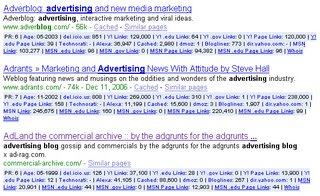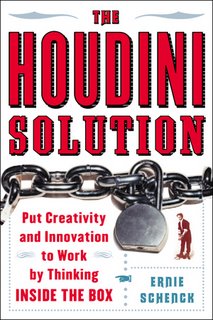Vacation, Interruption in Service
I'm mostly away from all things advertising -- TV off, no internet, books only -- till January 7. Feels weird not to blog, but what a relief.
Offtopic: Quote of the Week
"I'd like to get IQ boosting nutrients in concentrated form. Perhaps by eating vegetarians?" Dave Ross from NY commenting on a story about vegetarians being more intelligent.
Guardian: Kids' Brains Rot on Ads
Guardian runs a particularly vitriolic rant about how advertising is corrupting today's youths:
"On one side, a £30bn child-orientated market, armed with the latest multimedia weapons to lure, catch and keep the inner life of a small son or daughter. On the other side, a busy, guilty, stressed individual parent trying to avoid an embarrassing scene. Who do you think is going to win? [...]
The biggest influence on modern children [...] is not the school curriculum, the lectures of the faithful, panics in the press, ministerial initiatives or even family ethos. No, the biggest influence is marketing; the power of brands that invades the minds of the youngest."
Speaking of invading the minds of the youngest, here's the best book out there on the subject. Had it on my wishlist for a while, just got it today and can't stop reading. Did you know that "beoynd their own income [meaning allowances that amount to $15 billion each year], children also influence the purchase of more than $160 billion in family goods and services?"
But seriously. I grew up in a place where they didn't have any ads at all besides party propaganda and hand-drawn movie posters and the number of annoying kids per capita wasn't any lower.

"On one side, a £30bn child-orientated market, armed with the latest multimedia weapons to lure, catch and keep the inner life of a small son or daughter. On the other side, a busy, guilty, stressed individual parent trying to avoid an embarrassing scene. Who do you think is going to win? [...]
The biggest influence on modern children [...] is not the school curriculum, the lectures of the faithful, panics in the press, ministerial initiatives or even family ethos. No, the biggest influence is marketing; the power of brands that invades the minds of the youngest."
Speaking of invading the minds of the youngest, here's the best book out there on the subject. Had it on my wishlist for a while, just got it today and can't stop reading. Did you know that "beoynd their own income [meaning allowances that amount to $15 billion each year], children also influence the purchase of more than $160 billion in family goods and services?"
But seriously. I grew up in a place where they didn't have any ads at all besides party propaganda and hand-drawn movie posters and the number of annoying kids per capita wasn't any lower.

SEO Plug-In for Firefox
The following is a paid review for ReviewMe.

SEO for Firefox is a little plug-in for search engine optimizers (optimizators?) that ammends Google and Yahoo search results will all sorts of related trivia on sites that show up in the search results. This will give you an idea why certain site is ranked higher up than others for a particular search term. To give an example you guys can relate to: if you search for "advertising blog", these three come up at the top: Adverblog, Adrants and Adland (I was pleasantly surprised to learn that Ad Lab is #4).

If you turn the plug-in on, you'll find out that Steve Hall's site trails Martina's even though AdRants has a higher page rank and beats Adverblog in just about any other indicator. To figure out what's going on, you'll either have to use many of the other tools the site makes available or contract professional SEO services the site promotes.
In other words, the tool is nifty but does not paint a complete picture, although I like how it gives the number of del.icio.us and Bloglines links. The age is off by one year, but that's because the plug-in pulls its data from archive.org. The coolest of all other goodies is this typo generator, an essential tool for any business, cybersquatting or otherwise.

SEO for Firefox is a little plug-in for search engine optimizers (optimizators?) that ammends Google and Yahoo search results will all sorts of related trivia on sites that show up in the search results. This will give you an idea why certain site is ranked higher up than others for a particular search term. To give an example you guys can relate to: if you search for "advertising blog", these three come up at the top: Adverblog, Adrants and Adland (I was pleasantly surprised to learn that Ad Lab is #4).

If you turn the plug-in on, you'll find out that Steve Hall's site trails Martina's even though AdRants has a higher page rank and beats Adverblog in just about any other indicator. To figure out what's going on, you'll either have to use many of the other tools the site makes available or contract professional SEO services the site promotes.
In other words, the tool is nifty but does not paint a complete picture, although I like how it gives the number of del.icio.us and Bloglines links. The age is off by one year, but that's because the plug-in pulls its data from archive.org. The coolest of all other goodies is this typo generator, an essential tool for any business, cybersquatting or otherwise.
Interactivity May Cause False Memories
"Although object-interactivity will likely improve memory of associations compared to static pictures and text, it may lead to the creation of vivid internally-generated recollections that pose as real memories. Consequently, compared to information conveyed via static pictures and text, object-interactivity may cause people to falsely recognize more non-presented features."
"Learning Through Virtual Product Experience: The Role of Imagery on True Versus False Memories", Ann E. Schlosser (pdf), to appear in the December issue of Journal of Consumer Research. Excellent discussion and summary on Collision Detection.
"Learning Through Virtual Product Experience: The Role of Imagery on True Versus False Memories", Ann E. Schlosser (pdf), to appear in the December issue of Journal of Consumer Research. Excellent discussion and summary on Collision Detection.
Wired: Gadgets That Changed the World

It's like one of those MENSA test questions: which object doesn't belong here? Answer: all but one in the list of Wired's 10 gadgets that changed the world are media devices. Although I guess you can call the microwave "The Reality Food TV".
Advertising With Widgets, Part 2

This Purina widget has been downloaded over 15,000 times over the past two months. Not bad, considering the "eyeball-hours" it generates. Micropersuasion took time to count the others.
Earlier:
Advertising on Widgets
ROI of Second Life
(If you are on RSS, you won't see the embedded slides.)
Posted a few thoughts about the value of participating in Second Life and similar worlds over at HHCC blog along with some slides from recent presentations. Two sidenotes: 1) Huge thanks to FutureLab and MITX for having me speak; 2) Slideshare rocks.
Thumbvertising

Don't know if these people are for real but they must be all thumbs: "Thumbs are tomorrow's billboards. Born out of a niche market, thumb-space has gone mainstream! Media planners around the world add bang to over-stretched media budgets with thumb-vertising!"
-- love adrants' headline: thumbvertising is new Second Life
Writing for RSS Usability

When it's 3am, and you have to get up at 8am, and this is your only free time this week to catch up on RSS feeds, and the unread items are 2540, and you don't want to spend more than, optimistically speaking, 30 minutes going through them, which posts gets killed and how?
1. After some time writing and reading blogs, you get pretty good at scanning things. You look for trigger keywords. You recognize reduntant posts that appear all over the net on a particular day and kill those.
2. Feeds with no content and a single link back to the blog die an ugly death. Chances are someone else on the reading list has reblogged your precious post and it will come up in its full beauty two scrolls down the road.
3. You speed through the blogs with the traditionally low gold-to-crap ratio (judged subjectively, of course). BoingBoing is a great read in general and publishes useful snippets every once in a while, but the chances that it will have something relevant to the topic are statistically very small.
4. Cute but meaningless headlines die rot in headline hell, just like email subject lines that carry nothing but an out-of-context "re:"
5. I'm still debating the value of ALL CAPS in headlines. Probably a thumb down, but it hasn't become too bad yet.
Henry Jenkins Responds To Planners
For those of you following the lively debate around the newly minted concept of transmedia planning, Henry Jenkins just published his response in two parts (part 1, part 2).
There's a secondary strain running through the conversation about who's in charge of creating brand meanings. Brand managers must be thinking it's them (is "brand manager" an overstatement?), otherwise we wouldn't have "repositioning" and "rebranding" campaigns that are nothing but efforts to replace the old meaning of a brand with a new one. But you can't just swap one meaning for another. See, it's more like a cocktail. You have something in the glass that's your customer's head, then you pour something else, then add ice, and the resulting drink is never what you've just poured. In other words, new meanings don't replace old ones, they blend together into something that we haven't yet been able to measure.
There's a secondary strain running through the conversation about who's in charge of creating brand meanings. Brand managers must be thinking it's them (is "brand manager" an overstatement?), otherwise we wouldn't have "repositioning" and "rebranding" campaigns that are nothing but efforts to replace the old meaning of a brand with a new one. But you can't just swap one meaning for another. See, it's more like a cocktail. You have something in the glass that's your customer's head, then you pour something else, then add ice, and the resulting drink is never what you've just poured. In other words, new meanings don't replace old ones, they blend together into something that we haven't yet been able to measure.
Reports: Future of Internet, Web Video
Two reports I should've posted about earlier:
- From Pew Internet, Future of the Internet II with responses to 7 scenarios from 700+ thinkers.
- From Scott Kirsner, a book on Future of Web Video full of stats and interviews with key players.
- From Pew Internet, Future of the Internet II with responses to 7 scenarios from 700+ thinkers.
- From Scott Kirsner, a book on Future of Web Video full of stats and interviews with key players.
Ads on In-Game Radio in Virtual Worlds
Tony at Clickable Culture talks about ads for virtual shops that run on user-created radio for Second Lifers. The station that runs on millionaire Anshe Chung's land can be accessed at http://209.51.162.170:9072 (paste the URL into WinAmp or whatever player you have). If you played GTA: San Andreas, you'll remember the hilarious ads for Cluckin' Bell and Sprunk, too.
Microphone as Input Device

There have been a few online ads that let users interact with it through mics by singing or shouting, and here's the one from Lynx (aka Axe) deodorant that lets you blow the clothes off a freezing model.
-- via AdRants, Clickable Culture (with more examples)
New Book: Get Inside Creative Director's Brain

Ernie Schenck's new book "The Houdini Solution" gives a rare glimpse inside the head of the creative director who's been creating great campaigns on tight deadlines. Appropriately, every sentence reads like a slogan. Ever stared at a blank screen working on a campaign due first thing in the morning with little budget and a restrictive brief? That's the box mentioned on the cover, and Ernie suggests it's a blessing in disguise and offers plenty of examples and a chapterful of exercises. If you believe that creative thinking is an acquired skill and are looking for new ways to develop it, this book is for you.
Disclosure: we share the same agency roof.
Google Tests Radio Ads

image: Donna Bogatin
Google said "it had begun testing a system it acquired by purchasing dMarc Broadcasting in early 2006 for $102 million and which it subsequently built into its existing AdWords online ad system."
-- reuters
Follow-up: Embedding Ads into YouTube Players
A recent post about embedding ads into YouTube players to solve the monetization problem has attracted a suprising amount of attention and a number of great comments. Today, Ari Paparo from DoubleClick sent this clarification in:
"From a technical point of view, serving Flash ads into Flash content is actually suprisingly tricky. Security issues need to be overcome, as well as visual issues such as the masking of the creative into the expected dimensions. Not impossible, but not trivial either.
We've produced a demo showing how this can work.
In terms of formats, there's not going to be a single answer. Options for unobtrusive video can include "bugs" which overlay on top of the video, skinned players, clickable video (Sweetspotting), and other elements. These ad units can then be combined with post-roll video for a good mix of branded and direct response media.
For some examples of how this can be accomplished, I've put together an interactive demo of different video effects in a Flash player."
"From a technical point of view, serving Flash ads into Flash content is actually suprisingly tricky. Security issues need to be overcome, as well as visual issues such as the masking of the creative into the expected dimensions. Not impossible, but not trivial either.
We've produced a demo showing how this can work.
In terms of formats, there's not going to be a single answer. Options for unobtrusive video can include "bugs" which overlay on top of the video, skinned players, clickable video (Sweetspotting), and other elements. These ad units can then be combined with post-roll video for a good mix of branded and direct response media.
For some examples of how this can be accomplished, I've put together an interactive demo of different video effects in a Flash player."
Grand Theft Auto IV Will Have In-Game Ads
Take-Two Interactive and Double Fusion are partnering to bring in ads in Take-Two's games, the next installment of GTA apparently among them. GameSpy quotes Paul Eibeler from TTI:
"It's not just about shipping one box and then waiting for a sequel, but keeping that product alive in the marketplace. There is a tremendous amount of research that shows that anything in terms of downloadable content increases the box sales. So we will take our biggest brand (GTA) and have episodic content available in the marketplace. It's a way we are approaching games to maximize our revenue as we look into the next cycle."
"It's not just about shipping one box and then waiting for a sequel, but keeping that product alive in the marketplace. There is a tremendous amount of research that shows that anything in terms of downloadable content increases the box sales. So we will take our biggest brand (GTA) and have episodic content available in the marketplace. It's a way we are approaching games to maximize our revenue as we look into the next cycle."
SL: Socially Responsible Camping

I was preparing slides for the marketing 3 conference and hunting around Second Life's malls for a good illustration and by chance teleported to Caliente City Mall. Not only is it one of the more best retail environments in SL, its creators are also employing a new (to me anyway) -- and much cooler -- form of camping. Instead of sitting in front of the slots, people are actually sweeping floors, cleaning windows or playing guitars. The place looks alive, the traffic grows, and the realism is striking. Genious.
Speaking of the conference -- I'm traveling most of the week so not too many updates. I'll make up for it, though.
Eisner Museum of Advertising and Design

The Eisner Museum of Advertising and Design has some amazing online exhibits on hikifuda (Japanese ad handbills circa 1905, pictured above), ad work by Boris Artzybasheff, and history of Burma-Shave roadside signs.
Astronaut Misses First Golf Shot in Space

image: Daily Mail
"In one small swing for man, but one giant promotional stunt for a Canadian golf equipment company, cosmonaut Mikhail Tyurin set himself up for a shot that would put Tiger Woods to shame. With his goldplated six-iron in his hand, he spent more than a quarter of an hour positioning himself for the shot - not easy when half the time he was upside down. Finally he struck the ball ... and, with almost poetic inevitability, mishit it. It was what golfers call a shank - that awful moment when you hit the ball with the heel of the club and it goes off in some unpredictable direction.
The Russians, who are being paid an undisclosed sum by golf company Element 21, say the ball - weighing about 1/15th of a normal golf ball - could travel for more than three years, or 460 million miles."
-- Daily Mail
Earlier:
Amazon's Xbox Promo Fries Its Servers
Amazon today ran first of its promotions where they offered 1000 new Xbox systems at $100 each (instead of the regular $299). The units went on sale at 11am; at 10.59pm the site was nearly frozen. At 11.01, when the page finally loaded, all units were gone. Now they have a Digg-full of pissed-off customers:
-- "On the other hand, this promo seems poorly planned. The odds were incredibly small that any single person would get one, but it did succeed in pissing a lot of people off and crashing their servers.fuck amazon."
-- "I'm not renewing my prime membership. I don't mind losing out, but it shouldn't be because their fucking servers can't handle the load. Wall Street thinks the guys behind amazon.com are idiots. I think I agree, now."
-- "On the other hand, this promo seems poorly planned. The odds were incredibly small that any single person would get one, but it did succeed in pissing a lot of people off and crashing their servers.fuck amazon."
-- "I'm not renewing my prime membership. I don't mind losing out, but it shouldn't be because their fucking servers can't handle the load. Wall Street thinks the guys behind amazon.com are idiots. I think I agree, now."
Pay To Get Dugg

This ain't gonna last long, but for now you can pay $20 set-up fee and $1 per digg to hit, with some luck and budget, Digg's front page and enjoy the traffic goodness.
Data Points: Video
-- "Most leading ad executives expect a significant portion of broadcast and cable TV ad dollars to shift to online video by 2010, with 33 percent predicting that switch will be between 10 and 19 percent." (American Advertising Federation)
-- "47% of people (down from 63% two years ago) buying a high-definition TV set in the past year say they did so looking forward to watching TV shows in HD, according to a study by Frank N. Magid Associates." (Yahoo)
-- Slate: "The battle between HD-DVD and Blue Ray is meaningless because the physical media for video are a dying breed in general."
-- Media Life: "Nielsen reports that 78 percent of all viewers in DVR households who watch recorded broadcast primetime shows play them back within two days and 84 percent in three days."
-- The Inquirer: "A Nielsen study, which monitored a panel of 400 iPod users in the US, found that only one per cent of iPod users and 2.2 per cent of video iPod users watched videos on their gadgets."
-- "47% of people (down from 63% two years ago) buying a high-definition TV set in the past year say they did so looking forward to watching TV shows in HD, according to a study by Frank N. Magid Associates." (Yahoo)
-- Slate: "The battle between HD-DVD and Blue Ray is meaningless because the physical media for video are a dying breed in general."
-- Media Life: "Nielsen reports that 78 percent of all viewers in DVR households who watch recorded broadcast primetime shows play them back within two days and 84 percent in three days."
-- The Inquirer: "A Nielsen study, which monitored a panel of 400 iPod users in the US, found that only one per cent of iPod users and 2.2 per cent of video iPod users watched videos on their gadgets."
Whirlpool Offers 3D Models of Appliances for Google Earth

Press release (unearthed by Ogle Earth, via 3pointd): Whirlpool offers 3-D models in the Google 3D warehouse; architects and design professionals can now include Whirlpool and Gladiator brand appliances within their 3-D visualization designs. More than 120 top U.S. design firms currently use Google SketchUp for 3-D design and visualization. As the Google 3D Warehouse expands the number of 3-D objects available for designers, Whirlpool Corporation plans to expand its 3-D appliance model offerings to include Jenn-Air, KitchenAid, Maytag and Amana brands."
Earlier, I wrote on Brands in Games about Ikea furniture models surfacing up in the 3D Warehouse, but apparently Whirlpool either has made the official move first (Ikea's stuff could be fan-made) or has better PR people. Ogle Earth quips: "I wouldn't be surprised if you'll be able to push a "buy" button in SketchUp and have your inventory of virtual home furniture materialize on your doorstep."
More on the subject:
Idea: How to Put Ads into YouTube
So, I've been reading Bob Garfield's article in Wired about the uneasy relationship between YouTube and advertising and how the old TV world is falling apart (the mag runs another article on the future of TV in the same issue). He talks about how hard it is to monetize YouTube's content and lists a number of challenges.
"First, there's the basic question of where, exactly, to put the ads. Prior to the acquisition, YouTube refused to sell ads appended to either end of a video – like a TV commercial – on the grounds of safeguarding the viewer experience. This leaves as available ad real estate only the space adjacent to the video window – which is great for whoever is hosting the video. But [...] a significant portion of YouTube videos are embedded elsewhere, mainly on individual MySpace pages."
Well, here's one idea:

Embed a banner into the player -- it should be technologically easy since it's all Flash. To safeguard YouTube's user experience, show the ads only when the videos are embedded into third-party sites (or on YouTube site to unregistered guests). Equip the banner with secondary controls to let the users play the video ad if they are interested. I'm guessing that animated ads here would be too distracting, but static ones should be ok. Perhaps share the revenue with creators and registered users who embed the videos elsewhere and thus increase the number of impressions.
I'd love to hear your thoughts. Comments are open, and so is my email.
"First, there's the basic question of where, exactly, to put the ads. Prior to the acquisition, YouTube refused to sell ads appended to either end of a video – like a TV commercial – on the grounds of safeguarding the viewer experience. This leaves as available ad real estate only the space adjacent to the video window – which is great for whoever is hosting the video. But [...] a significant portion of YouTube videos are embedded elsewhere, mainly on individual MySpace pages."
Well, here's one idea:

Embed a banner into the player -- it should be technologically easy since it's all Flash. To safeguard YouTube's user experience, show the ads only when the videos are embedded into third-party sites (or on YouTube site to unregistered guests). Equip the banner with secondary controls to let the users play the video ad if they are interested. I'm guessing that animated ads here would be too distracting, but static ones should be ok. Perhaps share the revenue with creators and registered users who embed the videos elsewhere and thus increase the number of impressions.
I'd love to hear your thoughts. Comments are open, and so is my email.
Wired on Lonelygirl15, Future of TV
Wired runs a great feature on Lonelygirl15. Besides all the behind-the-scenes stuff, the article offers a glimpse into a future of TV:
"You make movies for the big screen, sitcoms for TV, and something else entirely for the Internet. That's the lesson of Lonelygirl15.
This Web series not only looks different, it's made differently than other filmed entertainment. As Bree's universe expands, each new character will have his or her own vlog. Flinders can't write and film them all, so new writer-directors have been hired and paired with actors playing the new characters. Unlike television, where writers sit in a room and come up with a single script, the Lonelygirl15 team comes up with a general plotline and then sends its writer-directors out to produce independent but interconnected videos. All the characters, in essence, have their own show."
"You make movies for the big screen, sitcoms for TV, and something else entirely for the Internet. That's the lesson of Lonelygirl15.
This Web series not only looks different, it's made differently than other filmed entertainment. As Bree's universe expands, each new character will have his or her own vlog. Flinders can't write and film them all, so new writer-directors have been hired and paired with actors playing the new characters. Unlike television, where writers sit in a room and come up with a single script, the Lonelygirl15 team comes up with a general plotline and then sends its writer-directors out to produce independent but interconnected videos. All the characters, in essence, have their own show."
Branded Butterfly Wings

Telegraph: "A glowing green logo drawn by scientists on the wing of a genetically altered butterfly could herald the day that the insects are adorned with adverts and slogans. A team at the University at Buffalo that developed the world's first GM butterfly has now adapted the work to create the fluorescent marking on the wings of the insect to demonstrate an innovative tool that will make it easier to find out what genes do, in this case those that play a role in making the patterns on wings, from stripes to eye spots."
Gotta give credit to the newspaper's imagination. The original article's abstract reads much more dryly: "Precise temporal and spatial regulation of transgene expression is a critical tool to investigate gene function in developing organisms."
If you are into ads and bugs, here:
-- via Ad Rag; image from the provisional paper at BioMed Central
Future: Planting False Memories
New Scientist is celebrating its 50th anniversary with a special compilation of forecasts for the next 50 years gathered from the leading scientists. Among the most directly relevant to advertising is this one from Elizabeth Loftus:
"Over the next 50 years we will further master the ability to create false memories. We will learn more about who is most susceptible and what works with what kind of people. The most potent recipes may involve pharmaceuticals that we are on the brink of discovering. When we have mastered the false memory recipes, we will need to worry about who controls them. What brakes should be imposed on police, lawyers, advertisers?"
Hope I'll live long enough.
Another interesting one is from Google's Peter Norvig: "In 50 years the [search] scene will be transformed. Instead of typing a few words into a search engine, people will discuss their needs with a digital intermediary, which will offer suggestions and refinements."
I wrote about something similar before: "Some advertising will be targeted not at humans but at their robotic assistants powered by artificial intelligence to make the most optimal purchase decisions."
-- via IFTF
"Over the next 50 years we will further master the ability to create false memories. We will learn more about who is most susceptible and what works with what kind of people. The most potent recipes may involve pharmaceuticals that we are on the brink of discovering. When we have mastered the false memory recipes, we will need to worry about who controls them. What brakes should be imposed on police, lawyers, advertisers?"
Hope I'll live long enough.
Another interesting one is from Google's Peter Norvig: "In 50 years the [search] scene will be transformed. Instead of typing a few words into a search engine, people will discuss their needs with a digital intermediary, which will offer suggestions and refinements."
I wrote about something similar before: "Some advertising will be targeted not at humans but at their robotic assistants powered by artificial intelligence to make the most optimal purchase decisions."
-- via IFTF
Brand as a Thrill Ride

"The Italian Job: Stunt Track" at Kings Island (and before that in Toronto) is a brand placement within a movie within a thrill ride. "The rides are based on the final scenes of the 2003 ‘Italian Job’ film and feature 75 per cent scale fibreglass MINIs. Travelling at speeds of up to 40mph and with the equivalent force of 1500 horsepower, the fibreglass MINI Cooper S Convertibles will dodge police cars, avoid a helicopter, shoot down a black tunnel and complete four, 360 degree turns."
-- Car Pages, stumbled upon the idea at Cubemate who probably meant this coin-op Mini ride:

Offtopic: A Very Transmedia Lawsuit
An older offtopic story, but very transmedia and therefore cutting-edge.
S.B.A. Music Publishing (rus), the Russian arm of the EMI Group, filed a lawsuit against Sergei Minaev, author of the bestselling Duhless (Spiritless) book about the plight of Russia's middle management, for alleged "playback and distribution of the Group's compositions". By playback they mean three printed quotes from Lou Reed's "Perfect Day", and The Smiths' "How Soon is Now" and "There is a Light That Never Goes Out." The music label seeks about $20K in damages. Here's the author's post in LiveJournal (rus, July 06).
Update [Nov 22 '06] Here's a write-up in English.
Speaking of books, the Cars blog complains about some very annoying product placement of Mercedes in James Patterson's Cross.
S.B.A. Music Publishing (rus), the Russian arm of the EMI Group, filed a lawsuit against Sergei Minaev, author of the bestselling Duhless (Spiritless) book about the plight of Russia's middle management, for alleged "playback and distribution of the Group's compositions". By playback they mean three printed quotes from Lou Reed's "Perfect Day", and The Smiths' "How Soon is Now" and "There is a Light That Never Goes Out." The music label seeks about $20K in damages. Here's the author's post in LiveJournal (rus, July 06).
Update [Nov 22 '06] Here's a write-up in English.
Speaking of books, the Cars blog complains about some very annoying product placement of Mercedes in James Patterson's Cross.
Subservient Store Clerks

Virtual Tooluxe combines the interactiveness of the Subservient Chicken with the some of the boldness of Shai to bring us two playful clerks in a fashion boutique that the site apparently promotes. Brush up on your French, too, or use Babel Fish. To save you some time, the word for "undress" that works is deshabillez. Some of the sequences are up on YouTube. I like how you can subscribe to their list and receive secret codes for more action.

Product Placement in Megachurches
To follow up on the last week's post, here're a few select quotes from a recent article at Knowledge @ Wharton:
"Advertising has begun to seep into churches, and the phenomenon shows no signs of slowing down, say academic, religious and marketing experts. Some advertisers are taking the next step: marketing products -- like an SUV -- with no intrinsic religious value through church networks. Churches offer offer a particularly tantalizing opportunity for those intent on network or "word-of-mouth" marketing."
See some data on megachurches from Hartford Institute for Religion Research, and a list of megachurches by state.
"Advertising has begun to seep into churches, and the phenomenon shows no signs of slowing down, say academic, religious and marketing experts. Some advertisers are taking the next step: marketing products -- like an SUV -- with no intrinsic religious value through church networks. Churches offer offer a particularly tantalizing opportunity for those intent on network or "word-of-mouth" marketing."
See some data on megachurches from Hartford Institute for Religion Research, and a list of megachurches by state.
Second Life Shorts

-- Austin-based GSD&M ad agency has launched Idea City (and this conference table is suspended in mid-air).
-- Ian Schafer from Deep Focus sums up the world of advice to SL debuntantes: "build relationships -- not islands." Another tasty sound-bite: "All those documentaries and (real) blogs about Wal-Mart killing mom-and-pop stores must be taken into consideration when entering Second Life."
-- IBM, Dell and Sun are all heading into SL.
-- Fortune's David Kirkpatrick looks into the future: "There's no reason why some version of a 3D world couldn't eventually offer as much functionality as we get today on the Web."
-- The Electric Sheep Company and Edelman have announced a competition for SL's best business plan.
-- Techdirt warns of media exhaustion: "While there's obviously some interest in virtual worlds like Second Life, the extent to which companies are trying to use it to make themselves look cool has gotten a bit silly, and a backlash -- of which these may be the first inklings -- seems inevitable."
For the previous round-up of SL-related news, go back to last week.
Giant KFC Logo Seen from Space

"KFC Corporation today became the world's first brand visible from outer space by unveiling a record-breaking 87,500 square feet, updated Colonel Sanders logo in the Area 51 desert. The event marks the official debut of a massive global re-image campaign that will contemporize 14,000-plus KFC restaurants in over 80 countries over the next few years.
The logo was built off The World's Only Extraterrestrial Highway in Rachel, Nevada, also known as the "UFO Capital of the World," and the epicenter of inter-galactic communication.
The logo consists of 65,000 one-foot by one-foot painted tile pieces that were assembled like a giant jigsaw puzzle: 6,000 red, 14,000 white, 12,000 eggshell, 5,000 beige and 28,000 black."
-- press release (via Michael Castellon)
It's big and beautiful, but first? This giant cover for Maxim magazine must be a public service announcement then, if KFC's is the first ad. Then there was this wonderful iPod-from-space prank. Not to mention this whole roofvertising and mapvertising thing. But still, well done.
Lifelike Mannequins

Moving Mannequins creates display mannequins with lifelike detail of skin texture, pigmentation and eyes. The mannequins, "when coupled with movement, stimulate emotion and draw excited attention to the display."
-- via shark ride
Earlier:
Mannequin Crowd Promotes Real Estate
A Post Worth $125
This may seem slightly offtopic, but isn't.
I once earned twenty bucks by writing a poem for someone's anonymous anniversary (yes, you can order custom-made -- and often bad -- poetry online). The five stanzas took me a day. The poem was objectively pretty crappy but, I think, still better than most of the postmodern stuff out there. At least, mine rhymed.
What Reviewme.com offers is sort of the same. Write poetry or prose for someone's business and get paid. To get a taste of their own medicine, they are giving $25,000 to bloggers who are willing to review them. That's $125 per review. For $25,000, reviewme is getting backlinks from 200 very connected sites. These are the blogs they are letting in: relatively high on Technorati, on Alexa, and on Google, all sites with a PageRank of 5-7, plus whatever windfall they'll get from the reblogs, syndicators and sploggers reprinting the original reviews.
Technorati already shows 500+ blog-links to the website. Reviewme's PR is now 1. If all goes according to the plan, in the next three months (that's approximately how long it takes Google to update its index) it will go up to 5 or 6. That's a very smart investment as far as search results standing is concerned.
Now, they are trying to attract businesses to pay for blogger reviews, but I think this particular well is poisoned. A comment on TechCrunch (see, they got linked by TechCrunch) sums it up, "Will people still be able to be honest if a product sucks? I don't think so..." There goes public trust in the medium and the reviews. Lots of bloggers who took the bait already sound apologetic:
"As a note, I am being paid to write up this review, but I can assure you, in my years of reviewing products, services, and software, I'm always up-front and comprehensive with my assessments."
Who will use Reviewme's services? I have no clue. Not the big brands, not after what just happened to Wal-Mart. Local services can't benefit much from reviews by bloggers hundreds of miles away. Dot.coms 2.0? Maybe they will, yes, to boost their PageRank and visibility, turning Reviewme and other similar services into not much more than a glorified link trading biz.
Besides, the service's reach into the blogosphere is limited. A quick search through the site's database reveals that none of the Technorati 100 elite have made themselves available. There are plenty of fellow ad bloggers, though, which made going through the list not unlike bumping into a colleague in a brothel (not that I would know) -- you quickly look to the side and feign absence. There must be a more graceful to work this model.
Hope that was worth the $125. If not, I'll do the next one in rhymes.
Update [Nov.13, '06]. It seems I was right about the link trading biz stuff. SEO Buzz Post writes that the person behind reviewme is a professional link builder.
I once earned twenty bucks by writing a poem for someone's anonymous anniversary (yes, you can order custom-made -- and often bad -- poetry online). The five stanzas took me a day. The poem was objectively pretty crappy but, I think, still better than most of the postmodern stuff out there. At least, mine rhymed.
What Reviewme.com offers is sort of the same. Write poetry or prose for someone's business and get paid. To get a taste of their own medicine, they are giving $25,000 to bloggers who are willing to review them. That's $125 per review. For $25,000, reviewme is getting backlinks from 200 very connected sites. These are the blogs they are letting in: relatively high on Technorati, on Alexa, and on Google, all sites with a PageRank of 5-7, plus whatever windfall they'll get from the reblogs, syndicators and sploggers reprinting the original reviews.
Technorati already shows 500+ blog-links to the website. Reviewme's PR is now 1. If all goes according to the plan, in the next three months (that's approximately how long it takes Google to update its index) it will go up to 5 or 6. That's a very smart investment as far as search results standing is concerned.
Now, they are trying to attract businesses to pay for blogger reviews, but I think this particular well is poisoned. A comment on TechCrunch (see, they got linked by TechCrunch) sums it up, "Will people still be able to be honest if a product sucks? I don't think so..." There goes public trust in the medium and the reviews. Lots of bloggers who took the bait already sound apologetic:
"As a note, I am being paid to write up this review, but I can assure you, in my years of reviewing products, services, and software, I'm always up-front and comprehensive with my assessments."
Who will use Reviewme's services? I have no clue. Not the big brands, not after what just happened to Wal-Mart. Local services can't benefit much from reviews by bloggers hundreds of miles away. Dot.coms 2.0? Maybe they will, yes, to boost their PageRank and visibility, turning Reviewme and other similar services into not much more than a glorified link trading biz.
Besides, the service's reach into the blogosphere is limited. A quick search through the site's database reveals that none of the Technorati 100 elite have made themselves available. There are plenty of fellow ad bloggers, though, which made going through the list not unlike bumping into a colleague in a brothel (not that I would know) -- you quickly look to the side and feign absence. There must be a more graceful to work this model.
Hope that was worth the $125. If not, I'll do the next one in rhymes.
Update [Nov.13, '06]. It seems I was right about the link trading biz stuff. SEO Buzz Post writes that the person behind reviewme is a professional link builder.
Revver Goes TV, Slingbox Goes Mobile
The next logical step for the booming online video - getting on the old tube; something I wrote Google could do with YouTube. CNet: "Fame TV, a new channel available in the United Kingdom and Ireland via British Sky Broadcasting's satellite service, has partnered with Revver to broadcast the Web site's content."
In a related convergence-transmedia rumor, "Slingbox has done some European deals to show place-shifted TV on mobiles here but has also tied up with a big mobile carrier in the U.S. which will be announced soon."
In a related convergence-transmedia rumor, "Slingbox has done some European deals to show place-shifted TV on mobiles here but has also tied up with a big mobile carrier in the U.S. which will be announced soon."
Study Names Most Familiar Ads in Games
"A new study from Phoenix Marketing International has examined advertising recall for 70 of the top video games on today’s market. Some of the top brands gamers remembered included Coke, Pepsi, Nike, and Adidas."
-- press release
-- press release
Slate on HeadOn Ad

A lot has been written about the HeadOn ad, but Slate's take on it offers something unique: "These ads give viewers headaches, thus spurring demand."
Advertising on Strippers, Marketing Churches

In Stores Now is a parody site, but the idea of putting brands in the line of sight is solid. Other suggestions include branded animals (check) and ads in churches.
Speaking of churches: "The process of church branding is just like in any other business -- lots of research both inside and outside the organization. The end result is effective communication that tries to create a relationship with 'customers'" (BrandChannel). You'll love the ChurchSavers (religious screensavers), and this Church Business site full of industry insight. Here's a suggestion that church communicators should embrace YouTube. Warship House Media caters to the tech-savvy with their Easy Worship 6.0. Church Marketing Sucks remains an undying classic.
The Future According to Siemens

Siemens published a study called "Pictures of the Future" in which it looks at services, technology, communications, transportation circa 2030. There are a few interesting insights, but it seems that like many other attempts at futurology, this one is too grounded in the present. Consider this tidbit: "Virtual reality: Using a VR headset and 3D joysticks, the person in the cafe joins the game against." Virtual reality through a headset is a recurring dream and may just as well happen one day, but joysticks are so today. How about manipulating computer game elements with brainpower? For a glimpse of the "real" future, check this "Extracting Video from the Brain" article.

Mystery in Advertising

It's like the Queen tape played backwards: if people can find hidden meanings in a bad Photoshop job, imagine how wild they would go if there were a real mystery. What happened here is that someone spotted this print ad for an expensive watch and claimed such watch couldn't exist; a heated discussion on a forum followed. See if you can guess what's wrong with the image.
On a related note, here's why all watches in ads are set to 10:10.

First Person Shooter Glasses

This DIY "First Person Shooter Glasses" project has been widely written about a few weeks ago, but I thought I'd archive it here anyway. I'm not sure how well it works and whether the eyes can focus on and register something that's that close, but I like how "transmedia" and yet low-tech it is. And it inspires ideas. One would be to replace the gun with a logo of your news channel of choice.
Advertising in Braille

Beleyes.nl, an online shop for vision-impaired, placed transparent stickers on the pushbuttons of the traffic lights. The shop's URL is written in Braille.
-- via ads of the world
Earlier:
Playboy in Braille
Advertising for the Color-Blind
Tool: How Color-Blind People See Your Ad
Target Sued Over Site Accessibility for Blind
Culture: Mac Guy, PC Guy in Japan

The Japanese versions of the Mac campaign. They don't have the one with the Japanese girl playing a digital camera, though.
Earlier:
-- Interview with the Mac guy actor (he's being "discontinued")
-- How to Dress Like the Mac Guy
Mannequin Crowd Promotes Real Estate

An outdoor installation of 100 mannequins dressed in branded t-shirts promotes new condominium residences in Atlanta. See the very cool images and videos here. Highly awesome!
-- thank you, Lori
Advertising Lab Turns Two

Today AdLab turned two. Many thanks to you all without whom any of this would make little sense. Thanks for reading, for writing, and for linking back. Your words of encouragement keep this thing going, and being picked by Comm Arts as one of the 50 essential bookmarks was a great morale boost, too. Special thanks to Future Lab who were the blog's first advertisers, and to everyone who syndicates AdLab elsewhere: FutureLab again, The AdFeed, Ogilvy PR. And, of course, blogging wouldn't be possible without the stimulating environments at MIT CMS where it started and Hill Holliday where it continues.
If you are reading the blog exclusively through an RSS reader, come take a look at the new, uh, look of the site. If you want to add a link to the "Readers' Links" section, tag the page at del.icio.us with "2adverlab".
How did the blog do this past year compared to the last birthday's stats? Let's see:
- Posts published: ~ 700 (same as year ago)
- Total page views: ~580,232 (up from ~130,000)
- FeedBurner subscribers: ~ 1,200 (up from 200 last November)
- AdSense ad revenue: ~ $5,000 yearly total (up from ~$1,000)
- Technorati back links: ~ 3,286 (up from 150). Rank ~3,000. Blogs linking back: ~600
- Google PageRank: 6 (no change)

FeedBurner RSS subscribers, all time:

Second Life Shorts

Not these shorts, though. Here's what we have to report.
-- Second Life apparently preps a roll-out into Asia and hires a PR agency Lewis, writes Brand Republic.
-- It also writes that Bartle Bogle Hegarty's offices "became the victim of a Second Life flash mob, who turned up sporting strap-on dildos and simulating various sex acts."
-- Second Life Herald fumes (not safely for work) over advertisers claiming in-world firsts: "It is a case of a bunch of desperate clueless fucktards trying to show how bleeding-edgy they are, and, given that SL is the bleeding-edgy flavor of the month, they are wraping themselves in the Linden cape of bleeding-edginess."
-- Crackunit.com suggests, "Why aren't advertisers, or people who are trying to 'import' brands from their First Life forced to wear some kind of huge advertising helmet? It'd protect them from rocks thrown by irate Second Lifers as well as marking them out as advertisers."
-- Catherine Smith, marketing director at Linden Lab, offers a piece of advice: "Keep it fresh, build the foundation and let your customers join in creating the experience, keep them involved, offer social context (discussions, parties, games, etc.), create connections to the real world - website, content uploads, social tools for connecting and sharing successes."
-- Here's a June paper from Universal McCann "Parallel Worlds" (list; direct link to pdf). A very interesting tidbit: "Second Life and World of Warcraft are currently working together to form a cross-genre community MMOG, SLoW. It's certainly a risk and is expected to take close to two years to build; the combination will allow hybrid interaction in a world of blended niches. This will be an exciting opportunity for marketers to test out new marketing techniques in an "otherworld" while breaking down the barrier of the fantasy genre." Never heard of this; will be interesting to confirm.
Update (Nov 10, 06): Tony Walsh points out that SLoW is not an official project.
-- Information Week: "Residents are looking for real-world money by setting up stores powered by Amazon.com. Since July, at least three retail projects have been launched in Second Life to sell books, music, kitchenware, electronics, and other items in the online retailer's catalog."
-- New brands in SL: Scion that can be modded by residents, a tabloid (coming soon, claims it's first), a British radio (it, too, says it's first).
Advertise on M&Ms

You already can order M&Ms customized with your name, but now the candies are becoming a real ad medium. MediaPost writes: "MasterFoods will go from being a media buyer to a media seller, offering other marketers a chance to place their corporate and consumer brands, logos and other messages on M&Ms chocolate candies. The new offering, dubbed "My M&Ms My Branding," includes brand placement on up to 17 of the 22 colors M&M offers."
Technorati: Blogosphere Growth Slows

David Sifry brings fresh numbers on the state of the blogosphere. Lots of graphs. The big news: "the doubling of the blogosphere has slowed a bit." On the other hand, Sifry says Technorati has become better at weeding out splogs, which, I think, means the number of "real" blogs is actually growing faster. The big number: 57 million. So many blogs and nothing on.™ Here. I've just said something unique.

Holographic Advertising 3D Displays by Holo FX

"AURA is a 3D holographic display medium designed for life-sized presentations. With its realistic human format, it can draw consumers close to a featured product exhibit." The company, Holo FX, claims it has "developed a line of exciting and innovative 3-D holographic display media for use in the advertising and display industries." Fairly new; the company was mentioned in July's Creative Online Weekly.
If you are into this stuff, check out Dimensional Studios who sell 3-D screens and large Pepper Ghost installations (like the one used to project Kate Moss into a glass pyramid). Use the search box below for more; I posted a lot about 3D displays last year.
Fortune on Personal Fabricators
Fortune writes about MIT's Neil Gershenfeld and his work at Center for Bits and Atoms: "Today your all-in-one device prints, scans, faxes and copies. Tomorrow it will cut, score, etch and sew. Want a new dining room chair? You'll design it on a PC and press PRINT, and your personal fabricator will create it for you right before your eyes. Just make sure tray No. 2 has enough wood." (via Make)
If you want to know more, check out Gershenfeld's recent book FAB. Rebang often writes about fabrication; here's a recent post about a shoe fabricated using a technology associated with rapid prototyping. Fabjectory is one company that prints out 3D objects from virtual worlds (games or Google Earth, for example) data: avatars, weapons, dragons. Here's a pic of some of their creations (more on Flickr).

What does this have to do with advertising? Here's a bit from an essay draft I wrote for Convergence Culture last month.
"The advances in technology, even that that is not ostensibly related to advertising but especially the technology of production and distribution of goods, will greatly influence the way these goods are advertised and here's one example. Yesterday, you would see an ad for a chair and head to the store to buy it. Today, you type in the store's URL, pay with a card and receive it in the mail in a few days. Tomorrow, you may be able to print the chair out on a 3-D printer that today is used for rapid prototyping of architectural and engineering models. The gratification will be truly instant as the time gap between seeing the ad and coming into possession of the goods disappears. How will instant manufacturing affect advertising practices? We can speculate that the ads for individual products will have to become more detailed, for example, if customers are to give up the comfort of having the opinions of friends and of having an opportunity to try the product in the store.
With the nature of merchandise reduced to a bucket of polymer dust and molding instructions, it is likely that chair manufacturers will face the problem well familiar to RIAA and MPAA. Once chairs and other things become content, the prospect of rampant chair piracy turns from unimaginable into very real.
The conversion of merchandise from contained and scarce atoms into ubiquitous bits, the idea described by Nicholas Negroponte in Being Digital, will present marketers with another dilemma. Brands in their essence are meta-data that describe the ephemeral qualities of a physical product. Without these meta-data, the chair I am sitting on is just that, a chair. It’s black, has two adjustable arm-rests, it swivels, rotates and rolls when pushed. The Ikea label on it adds a data layer on the top of its intrinsic descriptors. Now it's a chair that has been created by a certain designer in Sweden, it has a name, and its perceived value will vary depending on whether the society has agreed that Ikea's furniture is stylish and hip or cheap and not very durable.
Advertising has traditionally focused on adding meta-layers to such physical products, from Burma Shave creams to Gillette five-blade razors, but it has yet to learn how to attach these layers to the products that are data themselves. The relative decline of importance of recording labels coincided with the digitalization of music that has unbundled and disembodied the product that was once incased in brandable vinyl, magnetic tape or CD plastic. The label loses its meaning when you cherry-pick the product parts and then mash them up with other bits to create a unique product whose only true brand is you. What happens to the music bits today will happen to the chair bits tomorrow when you are able to download the arm-rests from Ikea and the upholstery from Crate & Barrel, mix them up and print them out."
If you want to know more, check out Gershenfeld's recent book FAB. Rebang often writes about fabrication; here's a recent post about a shoe fabricated using a technology associated with rapid prototyping. Fabjectory is one company that prints out 3D objects from virtual worlds (games or Google Earth, for example) data: avatars, weapons, dragons. Here's a pic of some of their creations (more on Flickr).

What does this have to do with advertising? Here's a bit from an essay draft I wrote for Convergence Culture last month.
"The advances in technology, even that that is not ostensibly related to advertising but especially the technology of production and distribution of goods, will greatly influence the way these goods are advertised and here's one example. Yesterday, you would see an ad for a chair and head to the store to buy it. Today, you type in the store's URL, pay with a card and receive it in the mail in a few days. Tomorrow, you may be able to print the chair out on a 3-D printer that today is used for rapid prototyping of architectural and engineering models. The gratification will be truly instant as the time gap between seeing the ad and coming into possession of the goods disappears. How will instant manufacturing affect advertising practices? We can speculate that the ads for individual products will have to become more detailed, for example, if customers are to give up the comfort of having the opinions of friends and of having an opportunity to try the product in the store.
With the nature of merchandise reduced to a bucket of polymer dust and molding instructions, it is likely that chair manufacturers will face the problem well familiar to RIAA and MPAA. Once chairs and other things become content, the prospect of rampant chair piracy turns from unimaginable into very real.
The conversion of merchandise from contained and scarce atoms into ubiquitous bits, the idea described by Nicholas Negroponte in Being Digital, will present marketers with another dilemma. Brands in their essence are meta-data that describe the ephemeral qualities of a physical product. Without these meta-data, the chair I am sitting on is just that, a chair. It’s black, has two adjustable arm-rests, it swivels, rotates and rolls when pushed. The Ikea label on it adds a data layer on the top of its intrinsic descriptors. Now it's a chair that has been created by a certain designer in Sweden, it has a name, and its perceived value will vary depending on whether the society has agreed that Ikea's furniture is stylish and hip or cheap and not very durable.
Advertising has traditionally focused on adding meta-layers to such physical products, from Burma Shave creams to Gillette five-blade razors, but it has yet to learn how to attach these layers to the products that are data themselves. The relative decline of importance of recording labels coincided with the digitalization of music that has unbundled and disembodied the product that was once incased in brandable vinyl, magnetic tape or CD plastic. The label loses its meaning when you cherry-pick the product parts and then mash them up with other bits to create a unique product whose only true brand is you. What happens to the music bits today will happen to the chair bits tomorrow when you are able to download the arm-rests from Ikea and the upholstery from Crate & Barrel, mix them up and print them out."
Microsoft Launches Virtual Earth with Billboards

click image to zoom
Microsoft launched Virtual Earth, an online 3D application that's part of the company's mapping site, and the first 15 cities shown in their full three-dimensional glory are peppered with billboards. The maps are displayed in the browser unlike its stand-alone Google Earth competitor, but you do need an Internet Explorer (no Firefox), a couple of hefty plug-ins, .NET 2.0, and a fairly powerful computer. Apparently, the floating billboards that look a lot like what you'd see in Second Life, are served through the Massive technology Microsoft acquired in May.
ClickZ writes: "Launch advertisers include Fox's theatrical division, Zip Realty, Nissan, and John L. Scott. The experience is the culmination of technologies from Virtual Earth, Microsoft's Massive in-game ad division and its Digital Advertising Solutions' platform."
The ads are flat (that is, you don't see much if you are viewing them sidewise) and clickable. A click opens a new browser window with the advertiser's website.
CNet has more details about the project: "Microsoft also is opening up the application programming interface for Virtual Earth 3D to allow developers to build the search features into their own applications and Web sites."
Here are some pictures of 3-D Boston:

An ad for Zip Realty. You'll find the same one in Seattle, with Seattle's name on it.

A dramatic vista that looks like a computer game.

Very nice texturing work. That's Trinity Church on Copley Sq. (compare to real photographs) and the Hancock Tower. If you look closely, you'll see me on the 41st floor waving at the satellite.
Also, read these earlier posts:
Google Earth Becoming Virtual World
Google Earth Runs AdWords
Google Earth Compatible With Other 3D Environments
Google Earth Becoming Advertising Tool
P&G Creates Virtual Reality Research Room
Research magazine (could go behind the subscription wall soon): "Procter & Gamble has created a new research facility [in Britain] which uses computer-generated imagery to re-create shops. Research participants enter the room, known as 'The Cave' and walk through the simulated store, looking at different displays, 'picking up' products to look more closely, and choosing to 'buy' the ones they like. Opened in July at P&G's offices in Weybridge, Surrey, 'The Cave' is used to test shoppers' reactions to store layouts, shelving, and product and packaging design. Eighteen projects are already underway with retailers including Tesco, Sainsbury, Asda and Boots, mostly in the beauty area where the shopping environment has a big effect on sales." The magazine also has a whole feature called Virtual Zone, but I don't think I'm subscribed to see it.
-- via msurveys
Earlier:
Game-like 3D Environment For Modeling Outdoor Campaigns
-- via msurveys
Earlier:
Game-like 3D Environment For Modeling Outdoor Campaigns
Analysis of Political Paid Search Ads

The Rimm-Kaufman Group published an analysis of a handful of political ads that appeared in search engines (mostly Google). Some of the findings: the blues were more negative than the reds but the reds were more numerous, no ad referenced Bush, only two ads linked to videos. The observation I liked the most: "Blue ads were more likely to include an exclamation point. Red ads were more likely to contain a question mark."
There is something haiku about packing powerful political proclamations into the puny 90 characters of an AdWords blurb.
-- thank you, Alan
Subscribe to:
Posts (Atom)


